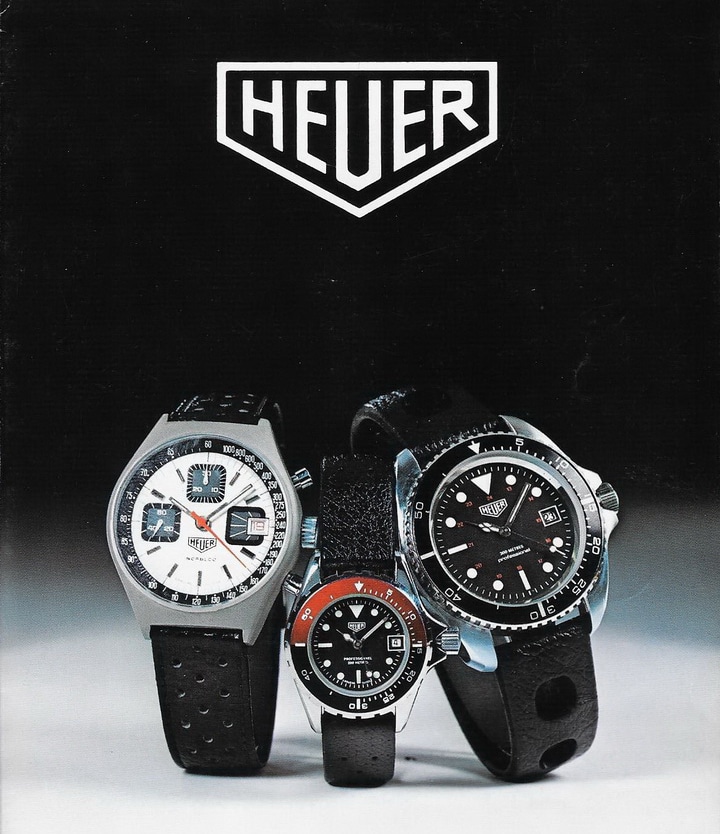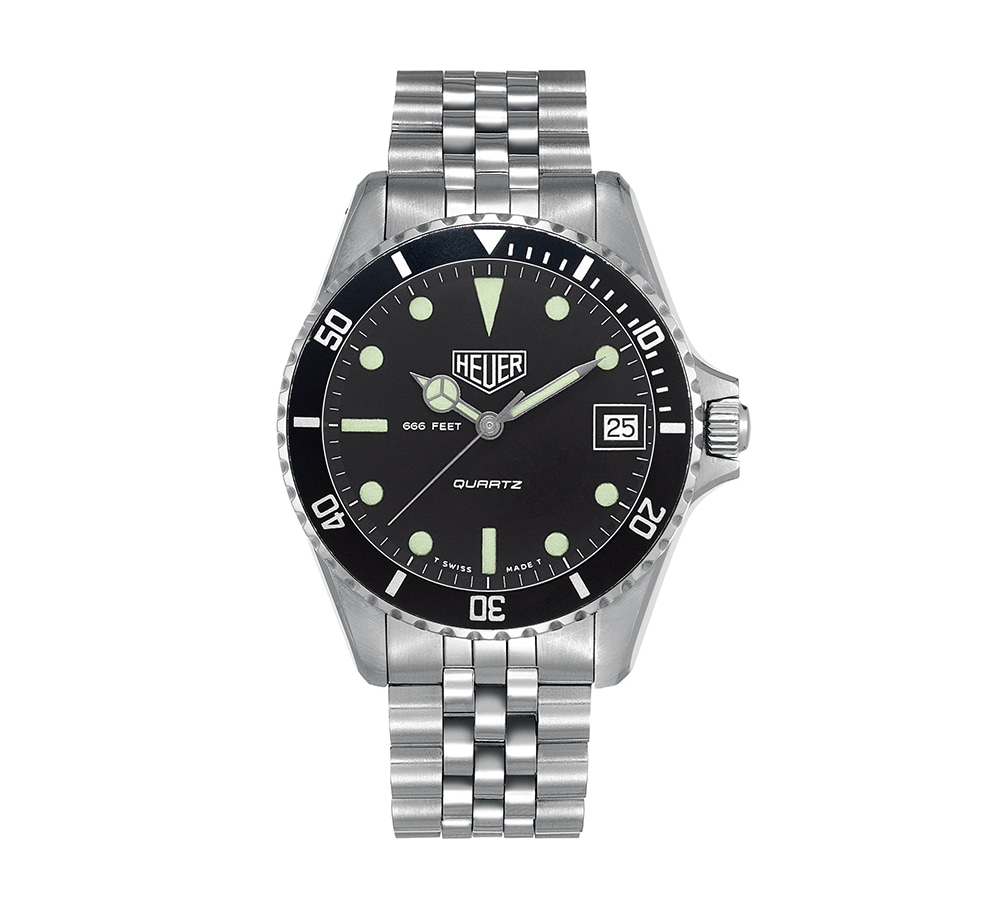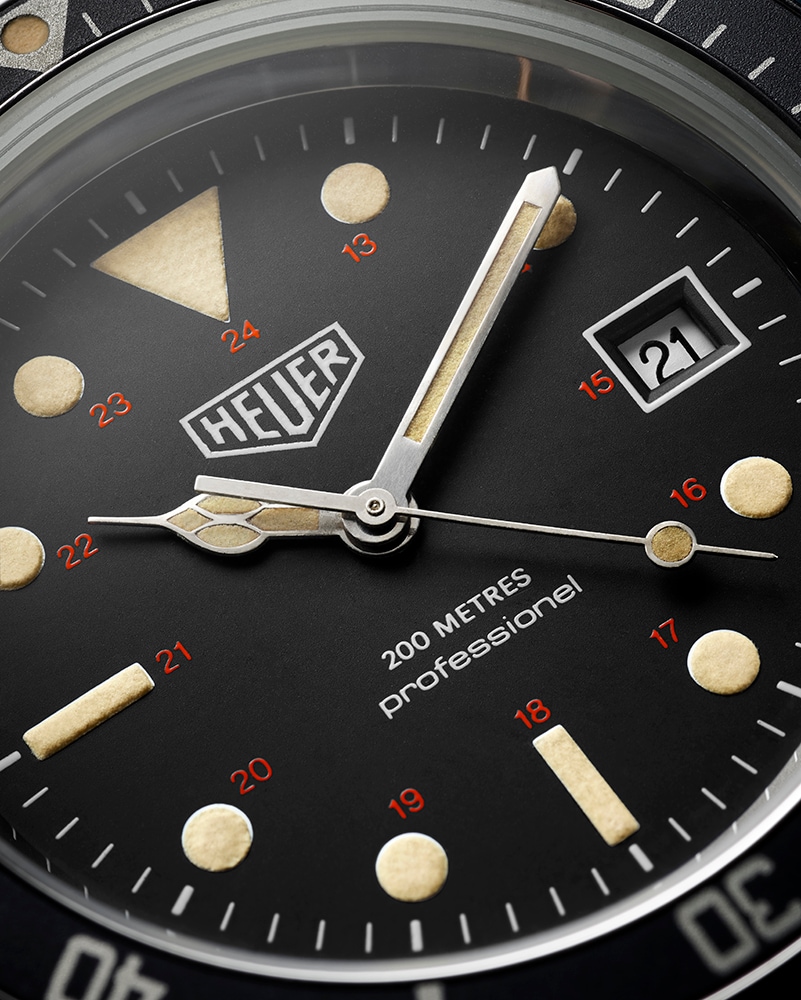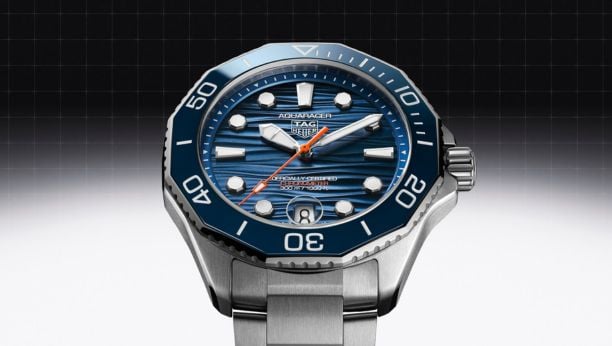VINTAGE COLLECTION
TAG HEUER 1000 SERIES
SUMMARY
The 1000 Series of dive watches from Heuer and TAG Heuer played a critical role in the history of the company. Developed at a time when Swiss mechanical chronographs faced industrial and economic challenges, and with Heuer having little background in this category of timepieces, these relatively inexpensive dive watches quickly met with enormous success.
Heuer quickly expanded its catalogue of dive watches to include a broad variety of colors and sizes, and the 1000 Series soon led to five other series of TAG Heuer dive watches, which represented a tremendous selection of watches and chronographs. The 1000 Series of dive watches (and its progeny) served as a bridge between the late 1970s, when the market for Swiss mechanical chronographs faced existential challenges, and the mid-1990s, when TAG Heuer would begin to reintroduce mechanical chronographs from its golden age. The 1000 Series of dive watches also laid the basis for the Aquaracer collection, which TAG Heuer introduced in 2004 and continues to this day.
The Heuer 1000 Series of dive watches came at a pivotal time for Heuer. By the late 1970s, the majority of the brand’s successful mechanical chronographs powered by the Calibre 12 movement had been discontinued, as the quartz crisis took hold. Still, Heuer remained dominant in the stopwatch and timing business, especially with new styles of electronic timers, and sales of these timepieces kept the company afloat through the 1970s. With sales of chronographs declining, however, it was clear that Heuer needed a new line of watches in order to survive difficult industry and economic conditions.
The answer for Heuer came in the form of a dive watch, but its launch was low-key. Heuer experimented with several quartz diving watches in the late 1970s, some of which only lasted a few months or years in production, but of these one stood out – the Reference 844 dive watch.
The 844 formed the basis for what would become the Heuer and then TAG Heuer 1000 Professional series - and from the 1000 series came the 1500, 2000, 3000, 4000 and 6000 series. For almost 20 years, these watches would dominate the Heuer and TAG Heuer catalogues and they came to define the brand’s look. But it was the 1000 Series that laid the groundwork for this entire generation of dive watches.
Jack Heuer has told the story of how the company known for its chronographs used for motorsports throughout the 1960s and 1970s came to offer a full catalogue of dive watches and chronographs:
“ISPO is Europe’s leading international trade fair for sporting goods and sports fashions, and for several years Heuer had taken a stand at the fair in Munich where we often found ourselves next to manufacturers of skin-diving products. They were mostly American firms and while chatting with their representatives at the 1979 fair I heard about the difficulties that they had buying private-label watches for underwater sports. They had had some bad experiences with watches bought from an importer in New York – in next to no time the watches let in water and they had had to deal with many angry customers.
That gave me the idea of trying to enter this market with a range of sturdy, Rolex-style diving watches with quartz movements, which would avoid overusing the winding crown as was inevitable with mechanical movements. To our great surprise our new diving watches were very well received by the market. We could not imagine then that this model – we called them the 1000 Series -- would be the very watch that was to help the company recover and get back into the black following the takeover by Piaget in 1982.
The following year, we extended the series to four sizes: two large ones for gentlemen’s watches and two small sizes for ladies. We also added a special piece to the metal bracelet so it could be stretched to fit over the sleeve of a wetsuit. All four models had a rotating bezel and extra-luminous dials, both features that TAG was to include a few years later in the full TAG Heuer range of sports watches.”

THE EARLY DAYS- 844/ 8440
The reference 844 (automatic movement) and its quartz counterpart (reference 8440), first appeared in the 1979 Heuer catalogue. These early watches were made in France by G. Monnin, a contract manufacturer who made watches for several other brands. Monnin was based in Charquemont, close to the Swiss border and only 25 kilometers from La Chaux-de-Fonds, the home of TAG Heuer today.
The movements on these early models were also French made, with the automatic FE 4611A being made by France Ebauches, at the time the largest French manufacturer of ebauche movements. FE was formed in 1965 and at one stage owned Glashütte Original. FE tried to survive by manufacturing movements in East Germany using low-cost labor, but sold Glashütte Original in the early 1980s.
The earliest models of Heuer’s dive watches featured a 24-hour dial (with the numerals 13 through 24 inside the usual markers for 1 through 12), as well as Cathedral hands, which were quickly replaced by the Mercedes hand design used on TAG Heuer’s range throughout the 1980s and 1990s.
By 1980, the 8440 was renamed as the 980.006 and the design of both the 844 and 980.006 were updated to remove the 24-hour markers on the dial. It also heralded the switch of production from France back to Switzerland, which is why these later watches carry the familiar “Swiss Made” text on the dial.
The reference 844/ 980.0XX watches had a distinctive case design that was very different to later 1000 Series watches and were offered only in a 42mm case. The two distinguishing features of the case are the shape of the crown guards and the soft, round lugs.
The 844/ 980.0XX continued all the way through to the end of the 1000 Series in 1990, with both automatic and quartz options being available throughout the model’s life. Later, there was even an Analogue/ Digital model that used the same basic case as the reference 844.
There many different variations of the early 844 and 980.xxx dive watches (circa 1979). For example, the reference 844/4, offers a day/ date feature and the reference 980.005 had a bright orange dial.
THE RANGE EXPANDS
Heuer’s first series of dive watches proved to be very popular, and by 1981 / 1982, the selection of sizes and colors was significantly expanded. While most of the early models were 42 mm cases with black dials, with some 28 mm watches offered for women, the catalogue would soon include dive watches with the following dimensions:
- Full size (or jumbo) - 42mm
- Men’s size - 38mm
- Mid-size - 32mm
- Lady’s size - 28mm
Each of the three smaller sizes share the same case design with sharper case lugs and less pronounced crown guards – but the details of the dials and hands generally match those of the full-size (jumbo) watches

1984 - THE 1000 SERIES
In 1984 the collection was formally named the 1000 series, with “1000” appearing just below the Heuer shield. The range now consisted of over 30 different models in stainless steel, two-tone, colour coating (black, pewter and green), gold-plated and black and gold finishes.
While the early Heuer cases are thick steel, later Heuer models gained the “L” suffix and a thinner case.
1986-1992: THE TAG HEUER 1000
The 1000 Series of dive watches made a seamless transition to life in the TAG Heuer catalogue, with only a few small changes. Apart from the obvious new “TAG Heuer” logo on the dial, the “1000” and “Professional” text moved to the lower part of the dial, while the “quartz” text was deleted.
The Reference 844 Automatic was discontinued in 1990, while the rest of the quartz 1000 Series lasted until 1992.
MOVEMENTS
- Early 844-FE 4611A
- Early Quartz- ESA 536.121
- Later 844- ETA 2872
- Later 1000- 964.114 or ETA 955.114/ 112

PRICE HIGHS AND LOWS
While the key to the success of the 1000 Series was its reasonable prices, there was a luxury version of the watch—a collection of solid 18 karat gold models. These models are easily identified by their nipple hour-markers and also have a unique bezel.
At the other end of the scale was the reference 980.043 dive watch, which has a distinctive 24-hour dial. Heuer called this an “economy” model, and it was water-resistant to only 30m (in part, because the crown did not screw down, as it did on the rest of the 1000 Series range.







